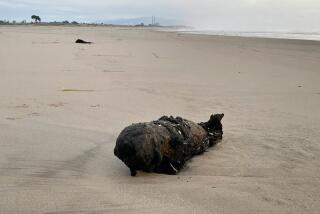Army Details Disposal Plan for Small Nerve Gas Bombs
- Share via
COMMERCE CITY, Colo. — Munition experts wearing blast-proof suits will use a pole to carefully move small nerve gas bombs from a scrap pile at the Rocky Mountain Arsenal to a steel destruction chamber, the first step in a painstaking disposal process outlined by the Army on Tuesday.
Officials from the Army and the Colorado Department of Public Health and Environment gathered at the arsenal northeast of Denver where the bombs were found to show off the state-of-the-art bomb disposal system.
Six grapefruit-sized bomblets have been found at the arsenal since Oct. 16. So far, three have been confirmed to contain sarin, the same chemical used in a Tokyo subway attack in 1995 that killed 12 people.
State officials and the Army were initially at odds about how to destroy the canisters and spent weeks negotiating a plan. On Tuesday, officials on both sides said they have found the safest system available.
“This system is totally contained. There will be no leaks of vapor or fluids from this system,” said Lt. Col. Chris Ross, a project manager for the disposal of munitions at the arsenal.
The Army has brought in an explosive destruction system in which the bombs will be destroyed singly. The system includes a giant blasting chamber mounted on a trailer.
The bomblets will be moved from a scrap metal pile by crews using a “hot stick” to a table near the blasting chamber, said Tim Blades, an operations supervisor and nuclear weapon expert. He said that will be the most challenging part of the process.
Each bomblet will then be placed in a metal shell with a small charge, Blades said. The metal shell will be put inside the blast chamber with another small explosive.
Then the explosives will be detonated inside the blast chamber--which has 2-inch-thick steel walls--to set off any active charge in the bomblets and to crack them open, Blades said.
Once the sarin has been exposed, the 50-gallon blast chamber will be filled with a chemical agent that will neutralize the sarin.
The chamber will then be heated and the bombs will be agitated by a hydraulic arm to ensure that the sarin has been neutralized, he said.
Once that process is complete, the liquid will be drained from the chamber into waste drums that will eventually be sent to commercial hazardous waste disposal facilities.
The chamber will be rinsed with water and then opened. Blades said the leftover metal scraps will be put in hazardous waste containers.
The process will take about 12 hours for each bomb and will involve a crew of no more than five people at a time, Blades said.
The system has been tested in Britain and one sarin bomb has been destroyed, he said.
Officials have also taken steps to ensure that any leakage won’t escape the arsenal or threaten public safety
A 30-by-40-foot structure will be built around the disposal system and will be vapor-locked using a vacuum system. All air that passes out of it will go through carbon filters.
A giant hangar-like structure will be built over the scrap metal pile where the devices are currently situated. This structure will also have an air filtration system.
“It’s protection from any unplanned release,” said Jeff Swanson, an ordinance expert with the state health department.
Officials hope to begin destroying the bombs Jan. 19 and continue for about 12 days, weather permitting.
Rene Bullock, a Commerce City city councilman, said he was satisfied that destruction of the bombs won’t threaten the area residents.
“I feel perfectly safe. Nothing could escape into the community,” he said.
The Army and Shell Chemical Co. made chemical weapons at the arsenal from 1942 through the mid-1960s. Pesticides were produced at the site by private companies until 1982. A $2-billion cleanup began in 1985.
Plans call for the arsenal to be converted into a wildlife refuge.
More to Read
Sign up for Essential California
The most important California stories and recommendations in your inbox every morning.
You may occasionally receive promotional content from the Los Angeles Times.













